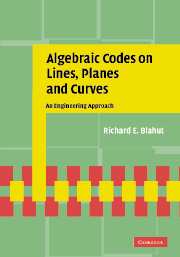Refine search
Actions for selected content:
6778 results in Communications and signal processing
References
-
- Book:
- An Introduction to the Theory of Graph Spectra
- Published online:
- 23 February 2011
- Print publication:
- 15 October 2009, pp 333-358
-
- Chapter
- Export citation
Index of symbols
-
- Book:
- An Introduction to the Theory of Graph Spectra
- Published online:
- 23 February 2011
- Print publication:
- 15 October 2009, pp 359-360
-
- Chapter
- Export citation
8 - Reed–Solomon codes in applications
-
- Book:
- Two-Dimensional Information Theory and Coding
- Published online:
- 05 June 2012
- Print publication:
- 15 October 2009, pp 146-157
-
- Chapter
- Export citation
Contents
-
- Book:
- Two-Dimensional Information Theory and Coding
- Published online:
- 05 June 2012
- Print publication:
- 15 October 2009, pp v-x
-
- Chapter
- Export citation

Algebraic Codes on Lines, Planes, and Curves
- An Engineering Approach
-
- Published online:
- 05 October 2009
- Print publication:
- 03 April 2008
Contents
-
- Book:
- Channel Codes
- Published online:
- 05 June 2012
- Print publication:
- 17 September 2009, pp vii-xiv
-
- Chapter
- Export citation
Index
-
- Book:
- Channel Codes
- Published online:
- 05 June 2012
- Print publication:
- 17 September 2009, pp 681-692
-
- Chapter
- Export citation
4 - Convolutional Codes
-
- Book:
- Channel Codes
- Published online:
- 05 June 2012
- Print publication:
- 17 September 2009, pp 147-200
-
- Chapter
- Export citation
1 - Coding and Capacity
-
- Book:
- Channel Codes
- Published online:
- 05 June 2012
- Print publication:
- 17 September 2009, pp 1-27
-
- Chapter
- Export citation
3 - Ethernet networks
-
- Book:
- Hands-On Networking
- Published online:
- 05 June 2012
- Print publication:
- 17 September 2009, pp 61-96
-
- Chapter
- Export citation
2 - Architectures and protocols
-
- Book:
- Hands-On Networking
- Published online:
- 05 June 2012
- Print publication:
- 17 September 2009, pp 29-60
-
- Chapter
- Export citation
5 - LAN devices and virtual LANs
-
- Book:
- Hands-On Networking
- Published online:
- 05 June 2012
- Print publication:
- 17 September 2009, pp 136-160
-
- Chapter
- Export citation
10 - Finite-Geometry LDPC Codes
-
- Book:
- Channel Codes
- Published online:
- 05 June 2012
- Print publication:
- 17 September 2009, pp 430-483
-
- Chapter
- Export citation
Frontmatter
-
- Book:
- Channel Codes
- Published online:
- 05 June 2012
- Print publication:
- 17 September 2009, pp i-vi
-
- Chapter
- Export citation
6 - Routes
-
- Book:
- Hands-On Networking
- Published online:
- 05 June 2012
- Print publication:
- 17 September 2009, pp 161-186
-
- Chapter
- Export citation
5 - Low-Density Parity-Check Codes
-
- Book:
- Channel Codes
- Published online:
- 05 June 2012
- Print publication:
- 17 September 2009, pp 201-256
-
- Chapter
- Export citation
4 - Wireless networks
-
- Book:
- Hands-On Networking
- Published online:
- 05 June 2012
- Print publication:
- 17 September 2009, pp 97-135
-
- Chapter
- Export citation
15 - LDPC Code Applications and Advanced Topics
-
- Book:
- Channel Codes
- Published online:
- 05 June 2012
- Print publication:
- 17 September 2009, pp 636-680
-
- Chapter
- Export citation
7 - Turbo Codes
-
- Book:
- Channel Codes
- Published online:
- 05 June 2012
- Print publication:
- 17 September 2009, pp 298-338
-
- Chapter
- Export citation
13 - LDPC Codes for Binary Erasure Channels
-
- Book:
- Channel Codes
- Published online:
- 05 June 2012
- Print publication:
- 17 September 2009, pp 561-591
-
- Chapter
- Export citation
